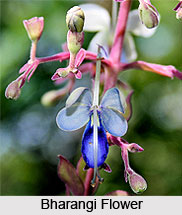 Bharangi is an Indian shrub which is 2.4 meters tall and is found through out India. This Indian Medicinal Plant is found more or less throughout India, in forests up to 1500m altitude. It is reported to be rare and endangered in Gujarat. India"s use of plants for health care dates back close to 5000 years. About 8000 herbal remedies have been identified in the Ayurveda, which are still in use. Bharangi is widely used in many disorders due to its various medicinal activities.
Bharangi is an Indian shrub which is 2.4 meters tall and is found through out India. This Indian Medicinal Plant is found more or less throughout India, in forests up to 1500m altitude. It is reported to be rare and endangered in Gujarat. India"s use of plants for health care dates back close to 5000 years. About 8000 herbal remedies have been identified in the Ayurveda, which are still in use. Bharangi is widely used in many disorders due to its various medicinal activities.
Different names of Bharangi
The Botanical name of this shrub is "Clerodendrum Serratum (L.) Moon". Some of the other common names by which this medicinal plant of India is called include "Bamanhati" in Bengali, "Bharangi" and "Duma" in Hindi, "Cherutekku", "Kantani", "Napalu" and "Kankabharnni" in Malayalam, "Chinda" and "Penjura" in Oriya, "Angaravalli", "Kandubarangi", "Chirudekku", "Sirudekku" and "Vadamadakki" in Tamil, "Bharungi" in Gujarati, "Kiritekki" and "Bharangi" in Kannada, "Bharang", "Bhargi", "Bharangi" and "Bharngi" in Sanskrit, "Bharangi" in Urdu and "Chiruteka", "Bharangi", "Gantubarangi" and "Panja" in Telugu.

Characteristic Features of Bharangi
Bharangi is a scarcely woody shrub which is 2.4 meters tall with bluntly and quadrangular stems. The young parts of the stem are normally smooth. The leaves of this medicinal plant are whorled and opposite, usually 12 to 15 cm long and 5.7 to 6.3 cm wide, elliptic or oblong, apex acute, margins coarsely and sharply serrate, glabrous, base acute; petioles very stout, 0.6 mm long. Flowers of Bharangi are pale blue in colour, numerous, in lax pubescent dichotomous cymes in the axil of a large, leafy, pubescent bract 1.3 to 3.8 cm long, the cymes collectively forming a large, pyramidal, terminal panicle; calyx 5 mm long, cup-shaped, truncate, not enlarged in fruit, lobes very small, triangular; corolla tube 1 cm long, cylindrical, hairy within at the base, the two upper and two lateral lobes are elliptic, obtuse, flat, spreading, about 1 cm long, the lower lobe lip-like, more than 1.3 cm long, concave, deflexed. Fruits of this shrub are purple in colour when ripe. Fruits are 0.6 cm long, broadly obovoid, somewhat succulent, normally 4-lobed with 1 pyrene in each lobe.
Medicinal Values of Bharangi
In the Ayurvedic and Unani medicine in India, the roots of Bharangi are highly valued as a specific remedy for respiratory diseases. They are considered antispasmodic, expectorant, carminative, febrifuge and tonic. In Ayurveda, they are used to treat coryza, anasarca, cough, epilepsy, dyspnoea and intermittent fevers. In Siddha, the roots of this medicinal plant and its leaves are used to treat fever, asthma, dropsy, coryza and mental disorders. They are also used in traditional medicine to treat dyspepsia and rheumatism, and to relieve cold symptoms. The leaves are also used as a febrifuge; boiled in butter and oil; the leaves of this plant are made into an ointment used to treat ophthalmia and headache. The bruised seeds, boiled in buttermilk are used as an aperient.











